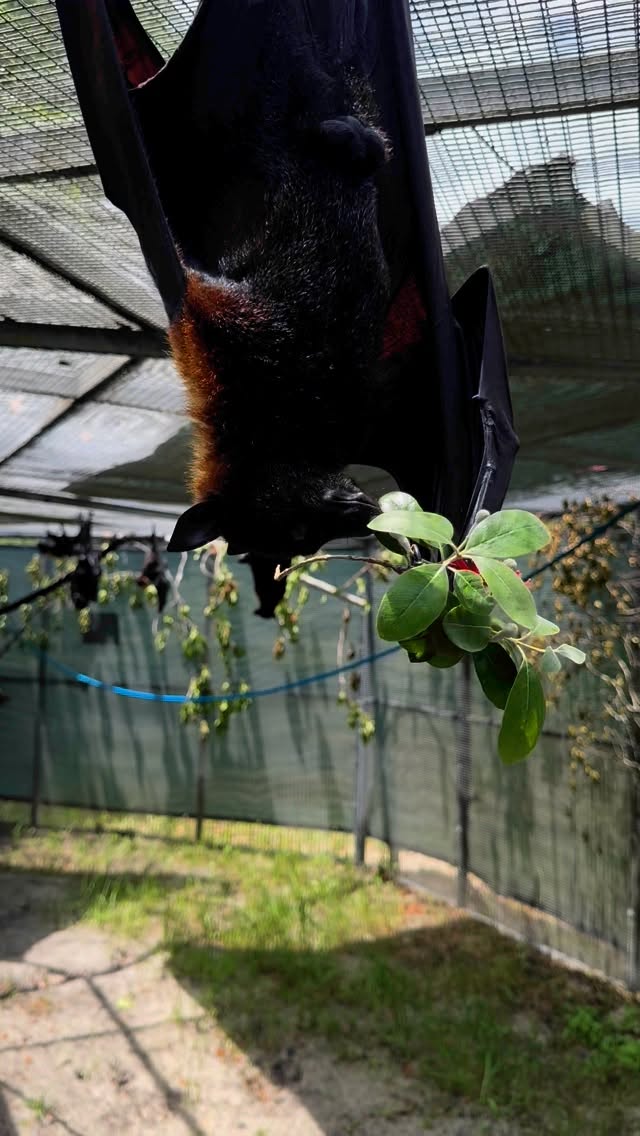- Skye the Fruit Bat’s Diet and Habitat at Lubee
- Nutritional Needs and Feeding Habits of Fruit Bats
- Role of Conservation and Wildlife Management at Lubee Bat Conservancy
- Importance of Bats in Ecosystems and Challenges They Face
- Educational and Conservation Efforts for Fruit Bats
Skye the Fruit Bat’s Diet and Habitat at Lubee
Today, Skye, a fruit bat at the Lubee Bat Conservancy, celebrates his fourth birthday. Fruit bats, also known as flying foxes, have fascinating dietary habits. Although they primarily consume fruit, their diet includes flowers, nectar, and leafy greens. This variety is not only crucial for their health but also for their role in the ecosystem. At Lubee, Skye enjoys a diverse diet, including browse—a term used to describe twigs and leaves—grown locally. Browsing is an important foraging behavior for many frugivores, and it mimics their natural feeding patterns.
Nutritional Needs and Feeding Habits of Fruit Bats
Fruit bats require a balanced diet to thrive, combining natural sugars, fibers, and nutrients. Fruits provide essential vitamins like vitamin C, while nectar and flowers can supplement their sugar intake. Leafy greens and vegetables contribute fiber and other micronutrients, supporting digestive health. This diversity ensures that bats maintain a healthy weight and energy levels. Due to their high metabolic rates, bats must feed frequently. The diet provided at conservancies like Lubee is carefully structured to meet these needs, promoting their overall well-being.
Role of Conservation and Wildlife Management at Lubee Bat Conservancy
Lubee Bat Conservancy, where Skye resides, plays a vital role in conservation and wildlife management. It aims to protect bat species and their habitats through scientific research, education, and community engagement. By focusing on bats’ ecological significance, Lubee fosters a deeper understanding of how bats contribute to biodiversity. Conservation programs include breeding initiatives, habitat restoration, and collaboration with local communities to preserve natural ecosystems. These efforts are essential in mitigating threats such as habitat loss and disease.
Importance of Bats in Ecosystems and Challenges They Face
Bats are keystone species in many ecosystems, providing essential services like pollination, seed dispersal, and insect control. By pollinating plants and dispersing seeds, they support the growth of fruit trees and other vegetation, crucial for sustaining biodiversity. However, bats face numerous challenges, including habitat destruction, climate change, and human-wildlife conflict. Diseases like white-nose syndrome also pose threats to certain bat populations. Addressing these challenges requires concerted conservation efforts and public awareness to ensure bats continue to fulfil their ecological roles.
Educational and Conservation Efforts for Fruit Bats
Educational programs at places like Lubee Bat Conservancy are designed to raise awareness about bats’ ecological importance and the necessity of their conservation. By engaging with schools, communities, and visitors, these programs aim to dispel myths surrounding bats and highlight their benefits. Conservationists advocate for the preservation of natural habitats and sustainable practices to protect these remarkable creatures. Through research, collaboration, and education, organizations are working to secure a future where bats, like Skye, can thrive for generations to come.
Skye’s birthday is a reminder of the intricate connection between conservation efforts and the survival of vital species.
*****
Source Description
Celebrate with birthday boy, Skye, who turns 4 years old today! 🦇🥳
Skye is currently munching on some browse, which was grown here at Lubee. While fruit bats do enjoy eating lots of fruit, their diet can include a variety of fun snacks. Things like flowers, leafy greens, nectar, and even veggies are just a few of the fun foods they will snack on! 🦇🌺🌱


